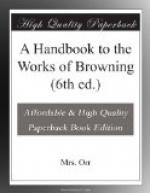This he actually did. But once more the Pope intervened: and Mr. Browning proceeds to give the literal substance of the “Instrument” of justification as it lies before him. In this, Pompilia’s “perfect fame” is restored, and her representative, Domenico Tighetti, secured against all molestations of her heir and his ward, which the Most Venerable Convent, etc. etc., may commit or threaten.
What became of that child, Gaetano, as he was called after the new-made saint? Did he live a true scion of the paternal stock, whose heraldic symbols Mr. Browning has described by Count Guido’s mouth?—
“Or did he love his mother,
the base-born,
And fight i’ the ranks, unnoticed by
the world?” (vol. x. p. 277.)
This question Mr. Browning asks himself, but is unable to answer. He concludes his book by telling us its intended lesson, and explaining why he has chosen to present it in this artistic form. The lesson is that which we have already learned from his Pope’s thoughts:—
“...
our human speech is naught,
Our human
testimony false, our fame
And human
estimation words and wind.” (vol. x. p. 277.)
Art, with its indirect processes, can alone raise up a living image of that truth which words distort in the stating.
And, lastly, he dedicates the completed work to the “Lyric Love,” whose blessing on its performance he has invoked in a memorable passage at the close of his introductory chapter.
TRANSCRIPTS FROM THE GREEK, WITH “ARTEMIS PROLOGIZES.”
Another group of works detaches itself from any possible scheme of classification: These are Mr. Browning’s transcripts from the Greek.
The “Alkestis” of Euripides, imbedded in the dramatic romance called “Balaustion’s Adventure.” 1871.
The “Herakles” of Euripides, introduced into “Aristophanes’ Apology.” 1875.
The “Agamemnon” of AEschylus, published by itself. 1877.
They are even outside my subject because they are literal; and therefore show Mr. Browning as a scholar, but not otherwise as a poet than in the technical power and indirect poetic judgments involved in the work. All I need say about this is, that its literalness detracts in no way from the beauty and transparency of “Alkestis” or “Herakles,” while it makes “Agamemnon” very hard to read; and that Mr. Browning has probably intended his readers to draw their own conclusion, which is so far his, as to the relative quality of the two great classics. Some critics contend that a less literal translation of the “Agamemnon” would have been not only more pleasing, but more true; but Mr. Browning clearly thought otherwise. Had he not, he would certainly have given his author the benefit of the larger interpretation; and his principal motive for this indirect defence of Euripides would have disappeared.




